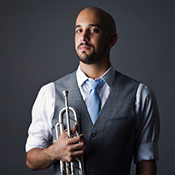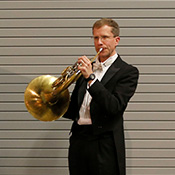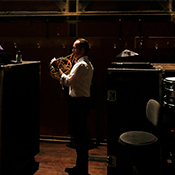
MSO Horn Players prepare for Schumann’s Conzertstück
Paul Kosidowski
PUBLISHED
Tagged Under: 2019.20 Season, French Horn, MSO Musicians
“Thirty seconds of glory, and 30 minutes of counting rests.”
That’s how MSO hornist Josh Phillips describes—with tongue in cheek and nowhere near his mouthpiece–a symphony horn player’s world. If there’s a kernel of truth in it, it certainly doesn’t apply to Robert Schumann’s Conzertstück, in F Major for Four Horns and Orchestra, which is featured on the MSO’s program November 1st and 2nd at the Pabst Theatre.
The 1849 Conzertstück is one of the most unusual and challenging pieces in the repertory of the French horn (typically called simply “the horn” by musicians). While concertos for horn and orchestra are rare enough—Mozart, Haydn, Richard Strauss—Schumann put four horns front and center for a three-movement “concert piece.”
“It’s a little nutty,” says Dietrich Hemann, one of the four soloists. “There’s a little bit of the mad scientist in it. It’s like he’s saying, ‘Okay, let’s see exactly what the limits of this instrument are.’”
“This instrument,” for Schumann, was the valved horn, invented in Germany in 1818, which uses buttons to change the path of the air moving through the horn. It was an innovation to the “natural horn,” in which the same effect required the player to change “crooks” to shorten or lengthen the air path. ►Watch MSO Hornist Darcy Hamlin demonstrate the differences here.
Schumann’s three-movement, 18-minute piece certainly does push the instrument to its limit. There are rapid arpeggios, blazing chromatic passages, and crazy key changes that would be all but impossible to play on a natural horn. It’s no picnic, even for the modern instrument. And its place on a MSO program was a long time coming.
“They came to me four years ago and asked me to do this piece, and I said no,” says Horn Principal Matt Annin, who will play the very challenging first horn part. “Then they asked me two years ago”—he pauses dramatically–“and I said no. Our seasons are very, very busy. And this piece requires just the right schedule. When they asked again, I consented.”
With a shrug, he adds, “I figured I’m not getting any younger.”
But schedule wasn’t the only consideration. Before he agreed to play the piece, Annin spent two days with the man who made his instruments, Karl Hill, to talk about the challenges. “The first part is extremely high,” he says, “and it would be very hard to do with my regular horn. There are some people who can do that, but I’m not one of those.”
The solution was to use a descant horn—an instrument that makes playing high notes a little easer—outfitted with a special mouthpiece.
“My part is very high as well,” says Hamlin, who will also use a special mouthpiece (“equipment is a big deal,” she says). In addition, the quartet did a little rearranging. “In order to make Matt’s part even remotely playable,” Hamlin explains, “we distributed little bits and pieces from his part into the other parts.”
When we talked in mid-October, the quartet had already met for a few rehearsals, and there were more to come before the regular concert rehearsals with the orchestra, including a meeting with MSO Music Director Ken David Masur. “I’m struck by just how much fun it is to play,” says Hamlin. “After practicing it a lot this summer, it’s just a lot of fun to play with everybody else.”
“The writing is so impressive,” adds Hemann. “Some of it does sit in the extreme register, but it suits the horn. “The heroic nature of the instrument really comes through very clearly. So I think all of that makes it a lot of fun both to play and to listen to.”
Part of the fun is being front and center, of course. In the two Beethoven symphonies also on this program, the horns are in their typical role, part of a carefully tuned and balanced orchestral ensemble.
The Schumann soloists won’t play in the Beethoven symphonies—which will feature Associate Principal Krystof Pipal—and the playing there will have a different quality.
“In the orchestra, you’re part of a larger group,” Annin says, “and you fit into that harmony. Most of the time you’re blending and finding your place in chords. Not sticking out.”
While the Conzertstück offers a bold exploration into the capabilities of “new” instruments. Beethoven’s first two symphonies sit at the cusp of tradition and innovation. Written at the dawn of the 19th century–a time when Beethoven’s mature style was evident in his chamber and piano music—these early symphonies show Beethoven to be still revving his creative engines. The great critic Donald Tovey wrote that the first symphony is a “fitting farewell to the 18th Century.” Most writers, similarly, emphasize the piece’s roots in the work of Mozart and Haydn. From the full-bodied, quasi-military Allegro that opens the first symphony to the comic buffa hijinx of the last movement of the Second.
But marks of Beethoven’s restless sense of innovation are certainly there. Traditionalists of the time were aghast that the first symphony didn’t begin in the harmonic home key of the movement. Beethoven biographer Jan Swafford calls the second symphony “high comedy,” but on a grand canvas. At its premier in 1803, he points out, it was the longest symphony written to date.
The biggest contrast, however, may be a matter of familiarity. Beethoven’s symphonies are standards of the repertoire, and will be heard around the world in this season, which marks the 250th anniversary of Beethoven’s birth. The rarely performed Conzertstück, however, is a glorious anomaly, which offers a rare chance to hear the MSO’s horn section in their true glory.



